The Northern Lights, also known as Aurora Borealis, are one of the most beautiful phenomena in the world. The lights appear when electrically charged particles from the sun race towards Earth, and then collide with gases in the Earth’s atmosphere.
One of the reasons you can only see the Aurora Borealis in the far north (or the Aurora Australis in the far south) is because the Earth’s magnetic field pushes those particles towards the poles. This means catching the lights usually involves quite the journey, however, it’s worth it to witness this natural wonder.
If you’re looking for a place to see the elusive Northern Lights in Europe, we have a few destinations where you are very likely to catch the lights painting the night sky.
Top Destinations In Europe To View The Northern Lights Travel Guide
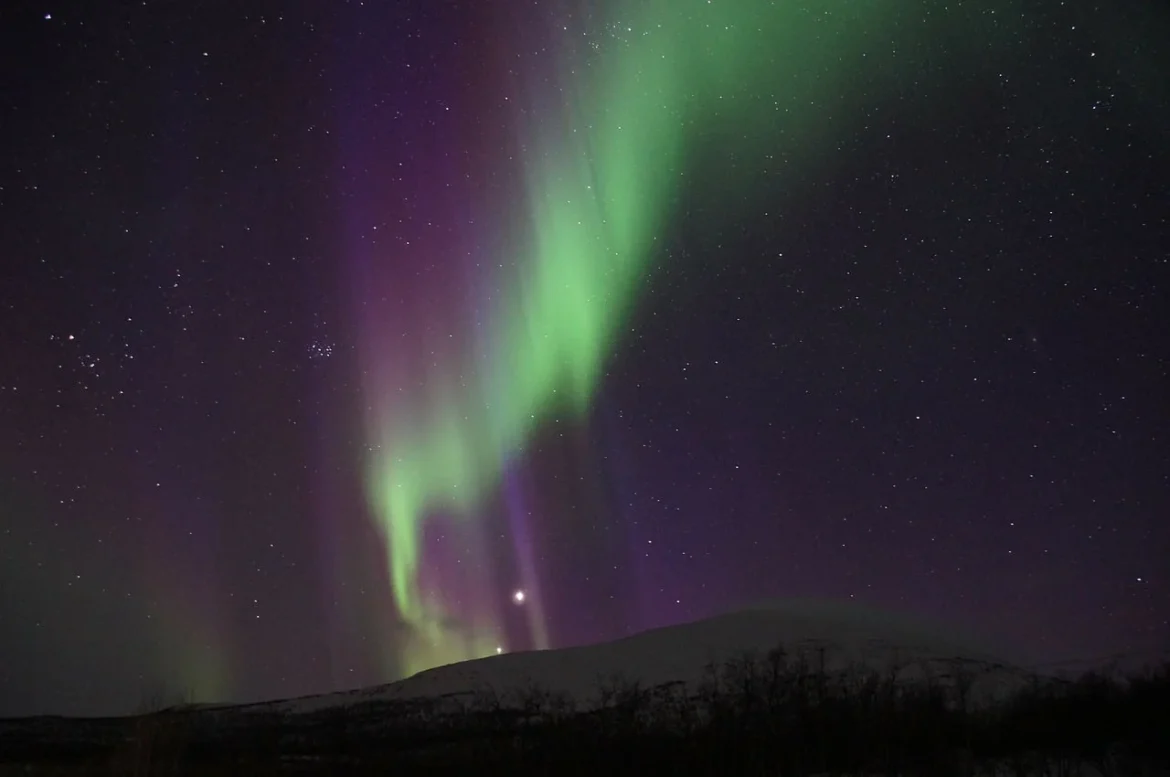
Abisko, Sweden
If you want to see the Northern Lights in Sweden, your best chance is to head to Swedish Lapland between September and March. Again, the rule of thumb when chasing lights is that the further north you travel, the higher the likelihood of seeing the lights.
One particularly popular spot in Sweden is Abisko National Park, which is home to the Aurora Sky Station. The station is situated on Mount Nuolja, about 900 meters above sea level, in an area that has very little light pollution to distract from the night sky.
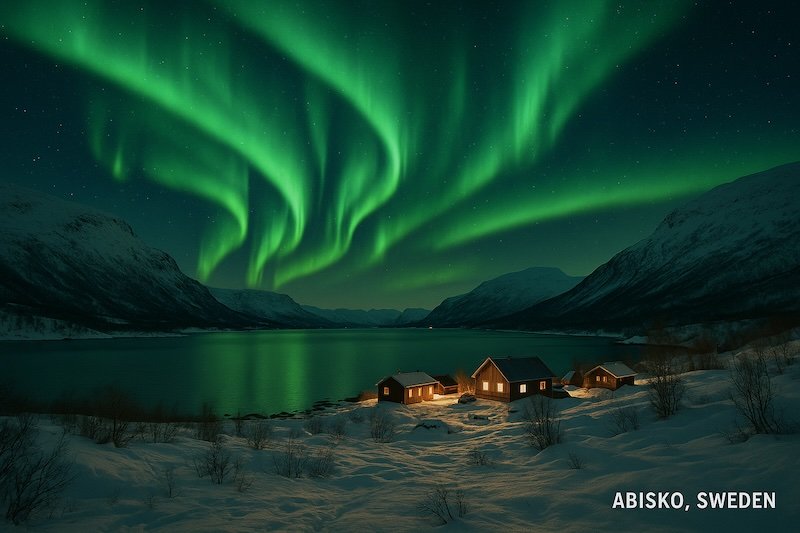
Where to stay in Abisko:
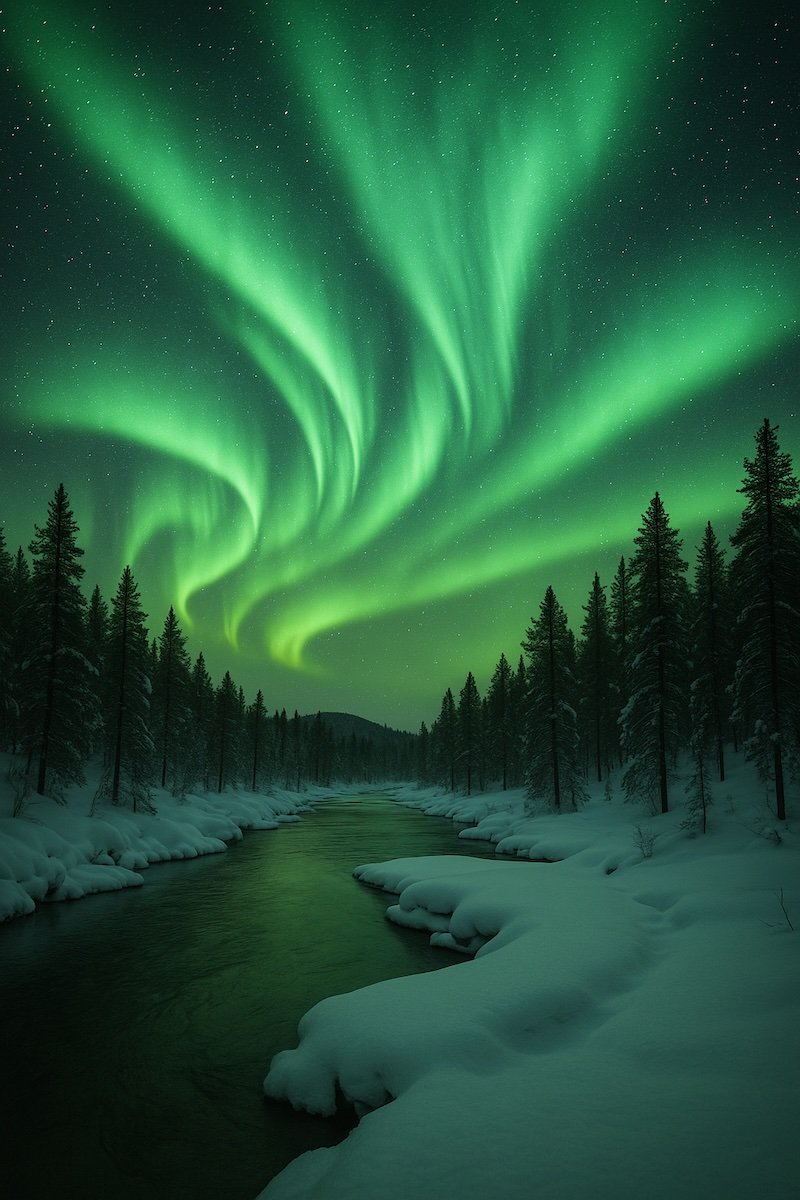
Inari, Finland
A trip to Finland is amazing no matter what time of year you visit, but winter in Lapland is especially magical. Did you know that in Finish Lapland it’s possible to see the Northern Lights up to 200 nights a year? You can begin to see the Aurora Borealis here as early as late August, and your chances increase the further north you go.
One of the best places to see the lights, as well as experience a unique culture, is Inari. Set on a lake some 250 kilometres north of the Arctic Circle, Inari is the Finnish capital of the indigenous reindeer herding Sámi people and it is steeped in a rich heritage. You can even stay in a glass igloo!
With more reindeer than people calling this place home, there is practically no light pollution, meaning you can just wander out to the lake and watch the magic unfold.
Where to stay in Inari:
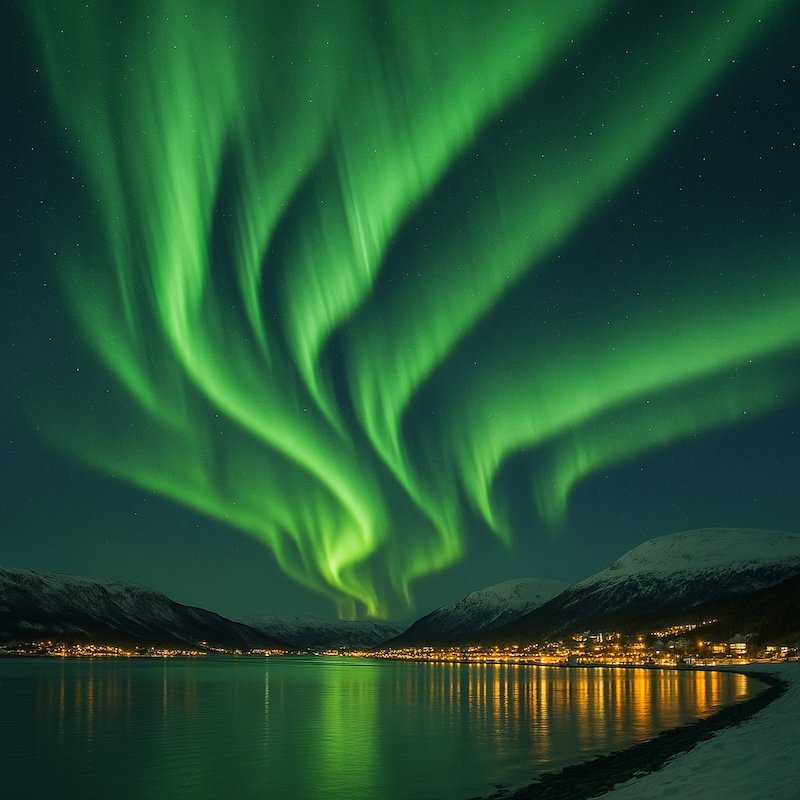
Alta, Norway
There are several excellent places to see the Northern Lights in Norway, but Alta continually comes out on top of every list. This particular destination is home to the world’s first Northern Light Observatory and it has even earned the nickname “The Town of the Northern Lights. Another cool reason to visit is to see the famed rock carvings of Alta; this is Norway’s only prehistoric World Heritage Site and it’s made up of some 6000 carvings.
When it comes to spotting the auroras, the best time to do so in northern Norway is between late September and early April. Of course, you could get lucky and see them outside that window, but you do have less hours of darkness on your side.
Where to stay in Alta:
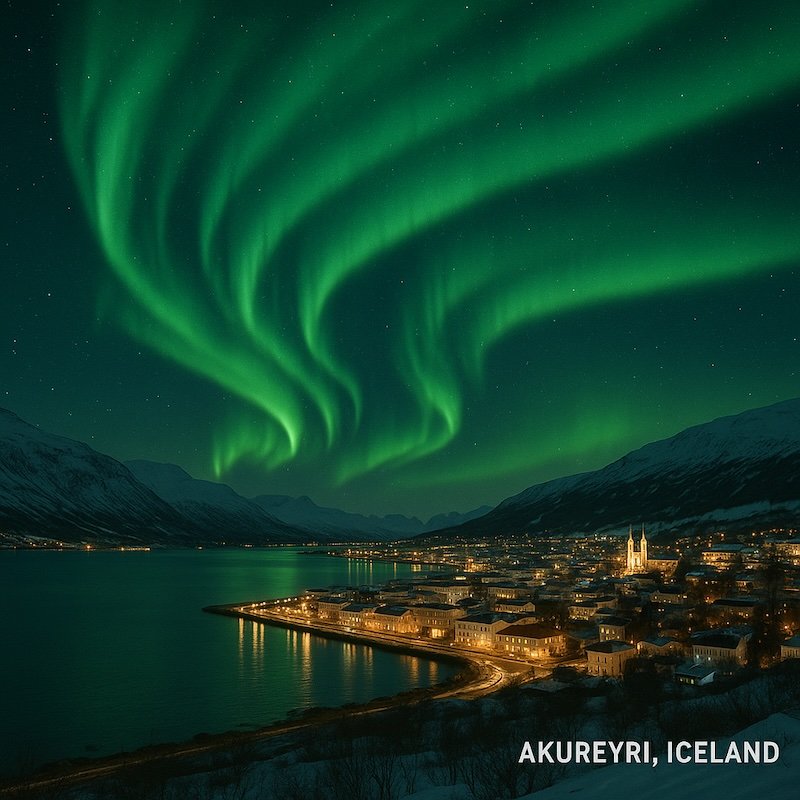
Akureyri, Iceland
Iceland has quickly become another popular destination for a European holiday chasing the lights. Not only is the scenery in this country jaw-droppingly beautiful, but from September to mid-April you also have the possibility of seeing the Northern Lights. The one thing to note is that while November through February are the darkest months of the year, they are also the cloudiest, so it really all comes down to luck.
Northern Iceland is home to some of the most dramatic scenery including thundering waterfalls and geothermal hot spots, so this can make for some great photography. Akureyri in particular is considered the unofficial capital of the north, plus its small population and low light pollution make it a good spot to chase the auroras. Just be sure to bundle up warm, because it can get pretty cold out there!
It’s possible to see the lights from Reykjavik, but of course, the further North you can get, the better your chances.
Where to stay in Akureyri:
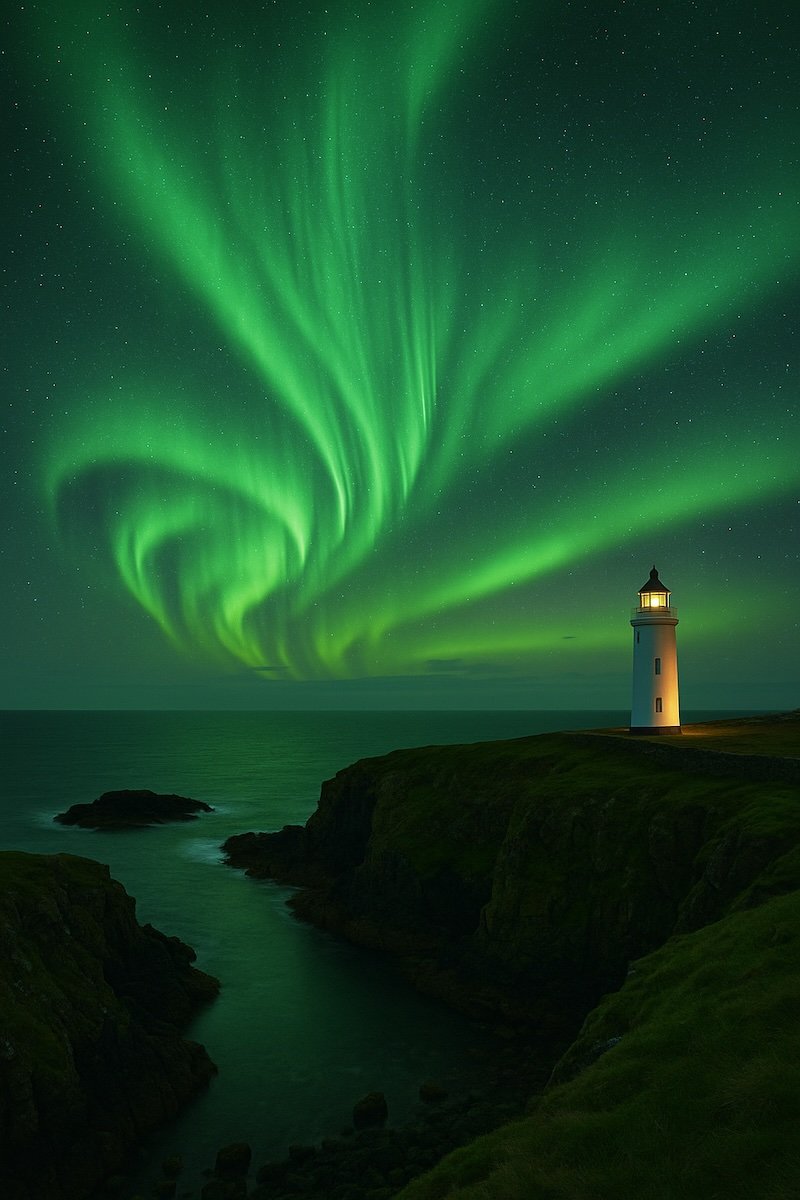
Shetland, Scotland
Scotland is often overlooked as a place to see the Northern Lights in Europe, but during those cold and dark winter months, the skies in northern Scotland can really light up.
While it’s a bit of a journey to get there, the Shetland Isles are an ideal destination. This archipelago is made up of more than 100 islands, 15 of which are inhabited. The isles also happen to be closer to Norway than mainland Scotland, so we’re talking pretty far north!
Also, this is a beautifully rugged and secluded destination, where you can explore a unique cultural heritage and learn more about the Vikings who left their mark on Shetland, which sounds like a pretty cool way to pass time while you wait for the lights.
Where to stay in Shetland:
Decca – Self Catering Shetland
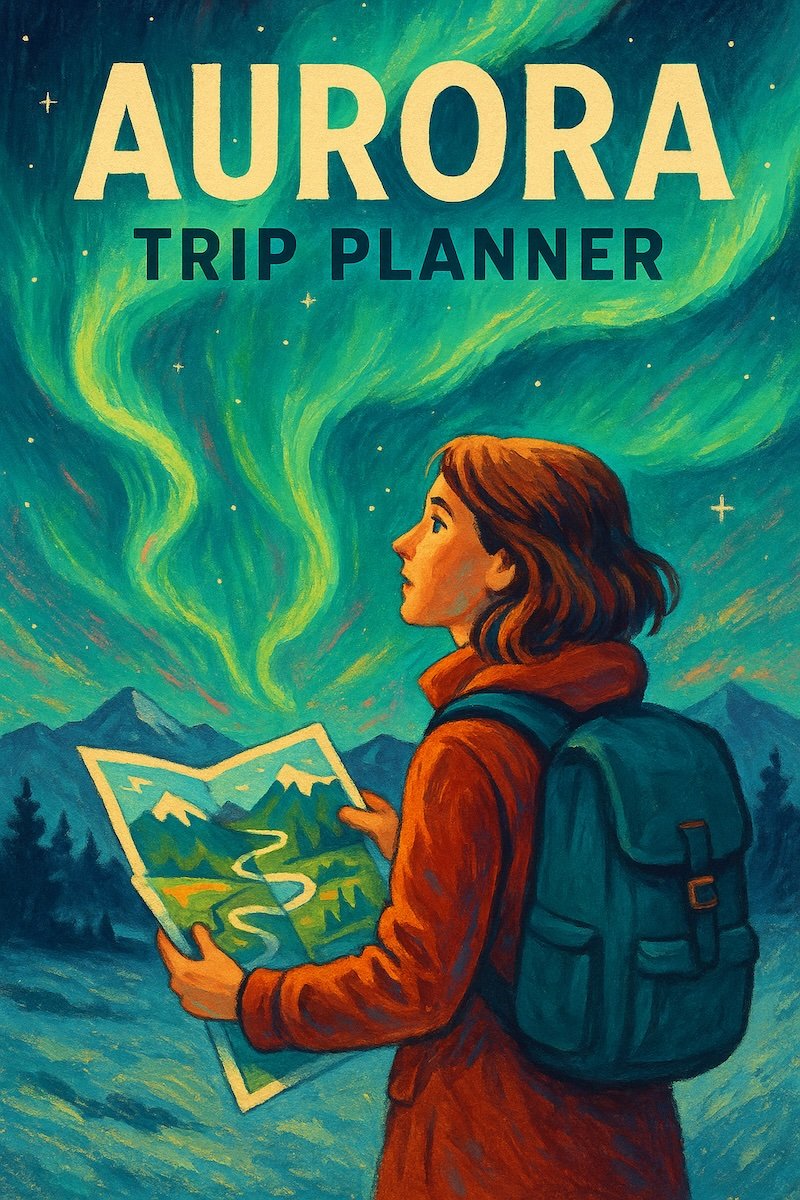
Aurora Trip Planner: How to Choose Dates, Gear, Routes & Photos (Itineraries, Checklists + FAQ)
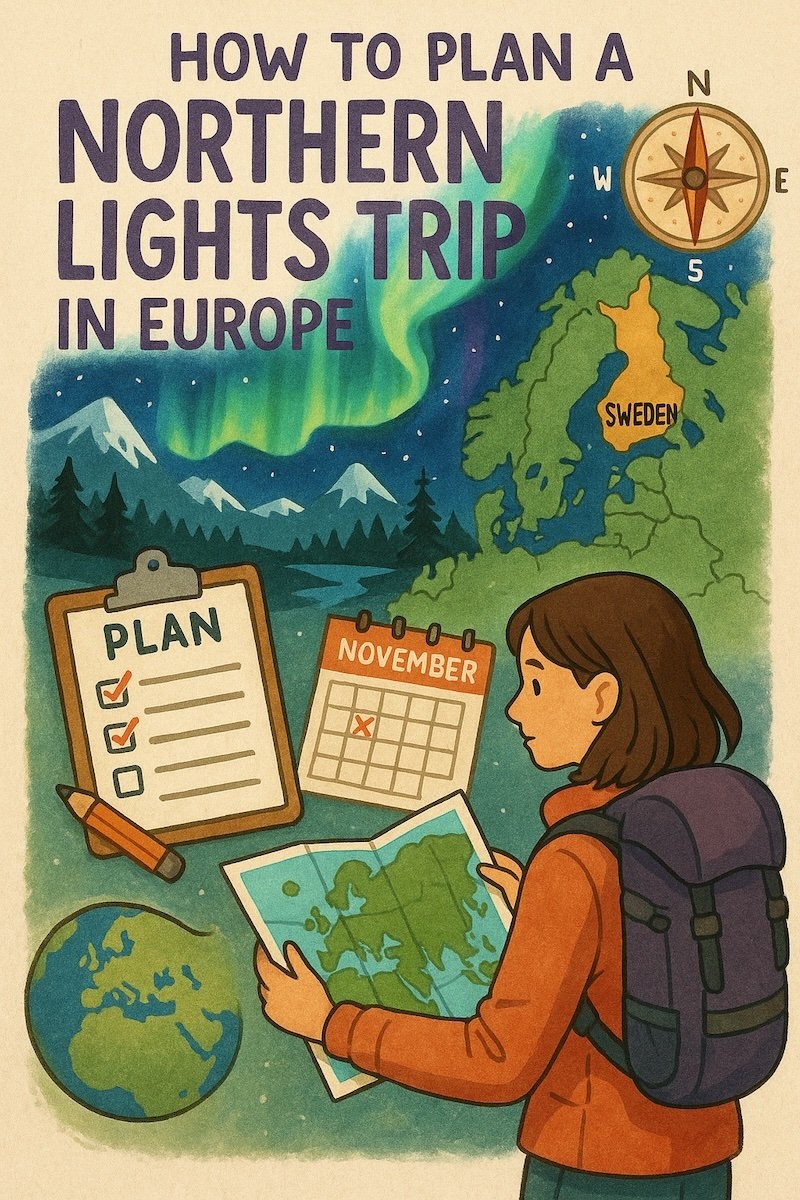
How to Plan a Northern Lights Trip in Europe (Step-by-Step)
1) Pick your season first, destination second
The Northern Lights can appear any dark, clear night, but your odds spike from late September to late March. Shoulder months (Sep/Oct and Mar) bring milder temps and reflective autumn/spring landscapes; mid-winter (Nov–Feb) offers the longest nights, but also more frequent clouds. Decide which trade-off you prefer, then choose the spot (Abisko, Inari, Alta, Akureyri, Shetland) that fits your dates.
2) Aim for multiple nights in one place
Even the “reliable” spots get socked in. Three to five nights in one base dramatically increases your chances of a clear window. Bonus: you get to actually enjoy daylight activities instead of bouncing between towns.
3) Read (and demystify) the forecast
- KP index (0–9): A rough indicator of geomagnetic activity. Higher KP can mean farther-south visibility, but low KP with clear skies often beats high KP under clouds.
- Bz (southward is good): If you peek at space weather, a negative Bz (southward interplanetary magnetic field) lets particles couple with Earth’s field more efficiently—often a better near-term signal than KP alone.
- Cloud cover: Your #1 forecast. Local weather sites + meteograms + satellite loops are your friends. Drive 30–60 minutes to escape cloud bands if you can.
4) Build a flexible nightly routine
Nap after dinner, check the sky every 30–45 minutes, and be ready for a late night. Auroras can pop at 8 p.m. or 2 a.m.—we’ve seen both. Set alarms, keep your warm gear by the door, and never talk yourself out of “just a quick look”.
5) Choose dark, open view spots
You want low horizons (to the north), minimal light pollution, and safe footing. Frozen lakes, quiet fjords, hilltops, beaches, and open moorland are ideal. In towns, walk 10–20 minutes out, or drive to an official viewpoint.
6) Book the right bed for your style
- Cabins/igloos with big windows if you like to watch in slippers.
- Simple lodges/guesthouses if you plan to be out in the car most nights.
- Guided aurora tours if you prefer an expert to do the cloud-dodging.
7) Manage expectations (and plan daytime joy!)
Memorable trips aren’t built on one night sky. Layer in sauna and snowshoeing in Inari, dog sledding near Alta, waterfall loops around Akureyri, frozen lake hikes at Abisko, or Viking sites in Shetland—then the lights are the glitter on top.
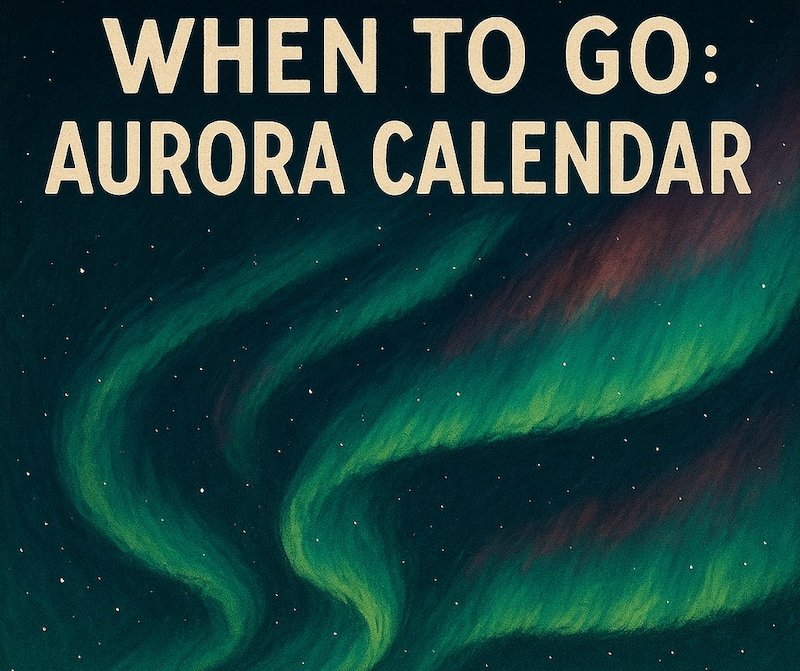
When to Go: Month-by-Month Aurora Calendar
Late September–October
- Pros: Equinox boosts geomagnetic activity; tolerable temps; autumn colors; fewer crowds.
- Cons: Transitional weather can be windy/rainy in coastal Norway/Scotland.
- Best bets: Abisko (rain shadow effect), Inari (golden birch), Alta (long nights begin).
November–December
- Pros: Long nights, Christmas markets, snow arrives inland.
- Cons: Cloudier stretches, storms on coasts, very short days above the Arctic Circle.
- Best bets: Abisko (microclimate), Inari (glass-igloo coziness).
January–February
- Pros: Deep winter ambience; frozen lakes for reflections; excellent ice activities.
- Cons: Coldest temps; driving requires winter skills; coastal winds.
- Best bets: Inari (stable cold, clear spells), Alta (dry inland valleys), Akureyri (north Iceland often clearer than the south).
March–early April
- Pros: Equinox bump, longer twilights (nice for composing shots), milder days, great snowpack.
- Cons: Solar angle rises (later starts for true darkness).
- Best bets: Honestly all five—this is the sleeper sweet spot.
Europe’s Aurora Hotspots Compared
| Destination | Latitude (approx.) | Typical Season | Cloud Tendency | Light Pollution | Ease Without Car | Signature Daytime | Budget Feel |
|---|---|---|---|---|---|---|---|
| Abisko, Sweden | 68.4°N | Sep–Mar | Drier “blue hole” microclimate | Very low | Good (chairlift + tours) | Aurora Sky Station, frozen lake hikes | $$ |
| Inari, Finland | 68.9°N | Sep–Mar | Cold, clear spells | Very low | Good (tours/igloos) | Sámi culture, reindeer, sauna | $$–$$$ |
| Alta, Norway | 69.9°N | Sep–Apr | Inland valleys clearer than coast | Low–moderate | Good (city base + tours) | Fjords, ice hotel, sledding | $$–$$$ |
| Akureyri, Iceland | 65.7°N | Sep–Apr | North drier than south | Moderate in town | Fair (tours help) | Waterfalls, geothermal baths | $$–$$$ |
| Shetland, Scotland | 60.3°N | Oct–Mar | Maritime, fast-changing | Low outside Lerwick | Fair (buses limited at night) | Viking heritage, seabirds | $–$$ |
Budget Feel is relative: $ (budget) to $$$ (splurge).
Suggested 3–5 Day Itineraries
Abisko, Sweden (3 nights)
Day 1: Arrive by train via Kiruna/Narvik—one of Europe’s most scenic rides. Afternoon walk in Abisko National Park. Evening: Aurora Sky Station chairlift (if running) or lakeshore watch.
Day 2: Snowshoe/cross-country ski; fika at the lodge. Evening: Guided minibus chase (they’ll know where the blue hole is).
Day 3: Day trip to Narvik fjords (Norway) if weather is socked in; back for a late-night lake session.
Pro tip: The lake ice makes mirror shots magical. Bring microspikes for traction.
Inari, Finland (4 nights)
Day 1: Check in to a glass igloo or lakeside cabin. Evening: Sauna + sky watch from bed (no shame).
Day 2: Siida Museum (Sámi culture) + reindeer farm visit. Evening: Aurora camp with open fire and grill (makkara time!).
Day 3: Daytime snowmobile or husky tour onto Lake Inari; nap; Evening: DIY stargazing on the ice (follow marked trails only).
Day 4: Slow morning; souvenir stop for duodji (Sámi handicrafts); final northern lights vigil.
Pro tip: Ask your host to set a “wake-up knock” if lights appear while you sleep.
Alta, Norway (3 nights)
Day 1: Check into Alta town (or Igloo Hotel if splurging). Evening: Guided aurora minibus to chase clearer inland skies.
Day 2: Dogsled or snowshoe morning; rock carvings museum (daylight). Evening: Coastal viewpoint watch with a thermos of cocoa.
Day 3: Day trip to Sautso Canyon (if open) or a fjord village. Evening: Last chase.
Pro tip: Inland valleys often clear faster than the fjord—your guide will zig where the clouds zag.
Akureyri, Iceland (4 nights self-drive)
Day 1: Drive or fly from Reykjavík. Soak at Forest Lagoon. Evening: Eyjafjörður turnout for auroras (north-facing).
Day 2: Goðafoss + Mývatn geothermal loop (Hverir, Mývatn Nature Baths). Evening: Hunt on the highlands edge (watch road conditions).
Day 3: Whale-watching in Húsavík (seasonal) or snowshoeing. Evening: Backroads north of town for dark skies.
Day 4: Weather buffer day; bakery crawl; final aurora dash if the forecast pings.
Pro tip: Iceland weather changes in minutes. Check road.is before any winter drive and carry snacks, blankets, and a full tank.
Shetland, Scotland (3 nights)
Day 1: Settle in Lerwick. Evening: Head to Clickimin Loch or Ness of Sound for a quick test look.
Day 2: Explore Jarlshof (Viking/Norse site) and Sumburgh Head (daylight); hearty pub dinner. Evening: Drive 15–30 minutes from town for dark beaches/moorland.
Day 3: Scalloway & west-side beaches. Evening: Keep watch for the “Merry Dancers”—Shetlanders’ nickname for the lights.
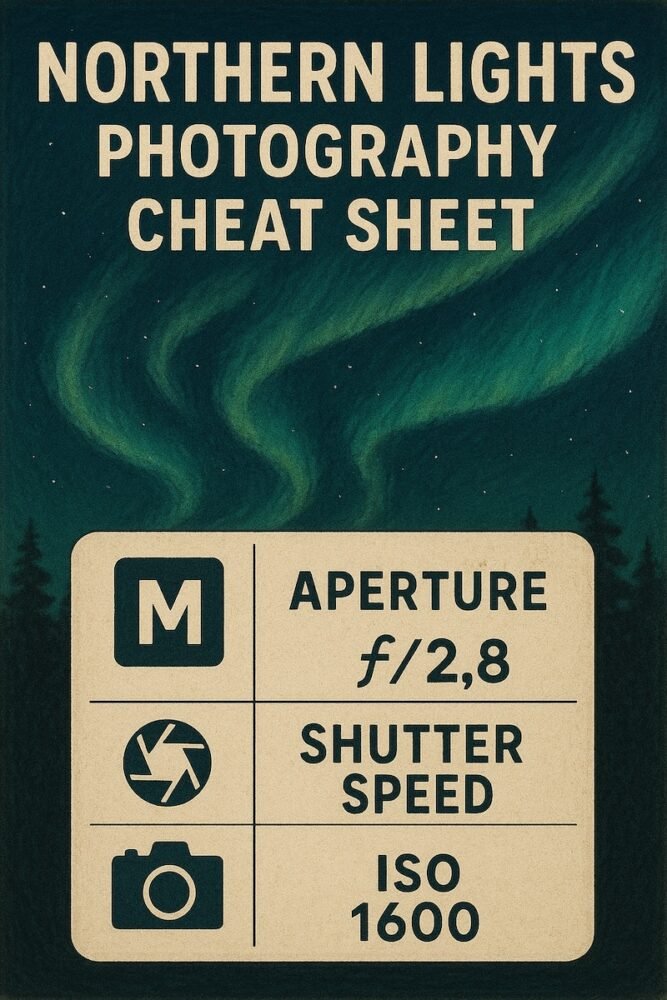
Northern Lights Photography Cheat Sheet
Camera Setup (Manual Mode)
- Lens: Fast wide-angle (14–24mm on full-frame; f/1.4–f/2.8).
- Focus: Manual; pre-focus on a distant light or bright star; use tape to lock it.
- Aperture: f/1.4–f/2.8.
- ISO: 800–3200 (start at 1600; adjust to taste).
- Shutter: 2–10 seconds (fast, dancing curtains = 2–4s; slow arcs = 6–10s).
- White balance: Auto or 3500–4000K for natural greens.
- Stability: Solid tripod + remote/2-second timer.
Composition Tips
- Include foreground: snow-covered trees, cabins, fjords, footprints, a friend in silhouette.
- Rule of thirds still matters—even when the sky is stealing the show.
- Turn off nearby lights; shield headlamps with your hand when moving to avoid light spill on snow.
Phone Photography (Yes, you can!)
- Use Night mode with a tripod or beanbag; set 3–10 second exposures.
- Lower the ISO if your phone allows to reduce noise.
- RAW capture (on newer phones) gives you editing wiggle room.
- Apps like NightCap (iOS) or ProCam can help with manual control.
Cold-Proofing Your Gear
- Keep spare batteries warm in an inner pocket; swap frequently.
- Avoid lens fog: cap lenses before going indoors; let gear warm gradually.
- Bring a microfiber cloth—snowflakes on glass are part of the game.
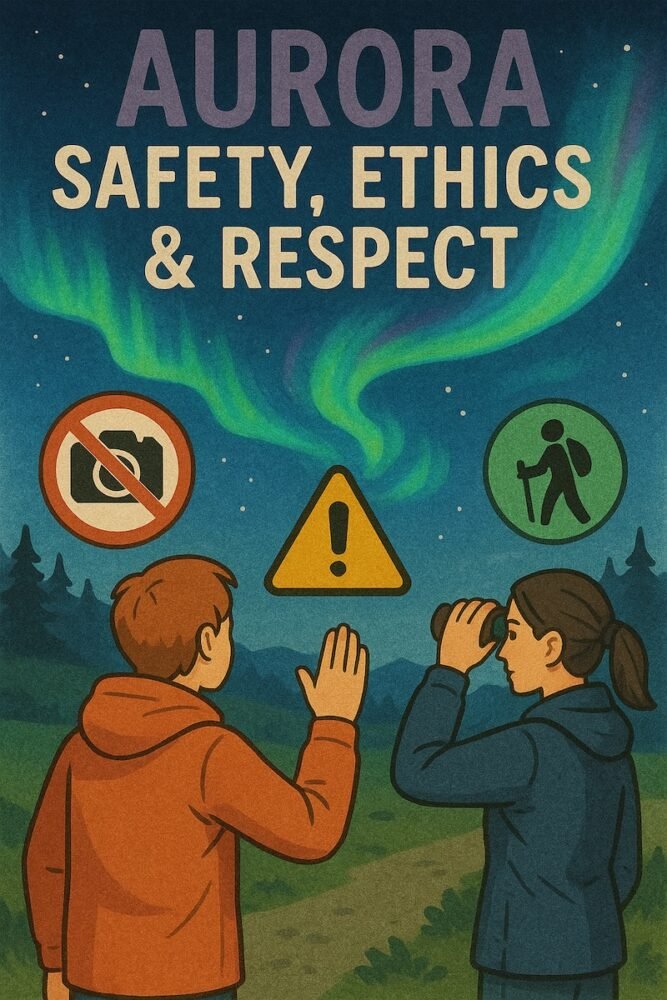
Safety, Ethics & Respect
- Dress smarter than you think: Base (merino), mid (fleece), outer (wind/waterproof), insulated boots, warm hat, liner + insulated gloves, and chemical hand warmers.
- Drive slow, lights low: On icy roads, smooth inputs win. If you pull over, park fully off the lane and use hazards sparingly.
- Leave no trace: Pack out everything, tread lightly on tundra and dunes, and give wildlife space.
- Honor communities: Ask before photographing people or private property, support local guides, and learn a few words (kiitos, takk, tack, tapadh leat!).
Budgeting & Booking Tips
- Bundle experiences: Many lodges offer aurora packages (gear + wake-up calls + hot drinks) that can be cheaper than booking all à la carte.
- Car rental: Reserve early for winter tires (often standard in Nordic countries). In Iceland, consider full insurance—gravel, wind and ice happen.
- Tours vs. DIY: One guided chase can teach you micro-locations; then DIY the rest.
- Food: Self-cater breakfasts/lunches, save dinners for a couple of splurges.
- Sample nightly ranges (very rough):
- Budget guesthouse: €70–€120
- Midrange hotel/cabin: €120–€220
- Specialty stays (igloos/ice hotels): €300+ (book far ahead)
Printable Checklists
Aurora-Night Pack List
- ☐ Headlamp (red mode) & spare batteries
- ☐ Hot drink in a thermos
- ☐ Hand/foot warmers
- ☐ Power bank + cable
- ☐ Tripod + remote
- ☐ Microspikes (for ice)
- ☐ Map with marked dark spots
- ☐ Snacks (nuts, chocolate, fruit)
Camera Quick-Start (Write on a sticky!)
- Focus: manual, infinity (taped)
- Aperture: f/1.8
- ISO: 1600
- Shutter: 4 sec (adjust to speed of aurora)
- WB: 3800K
- Timer: 2 sec / Remote on
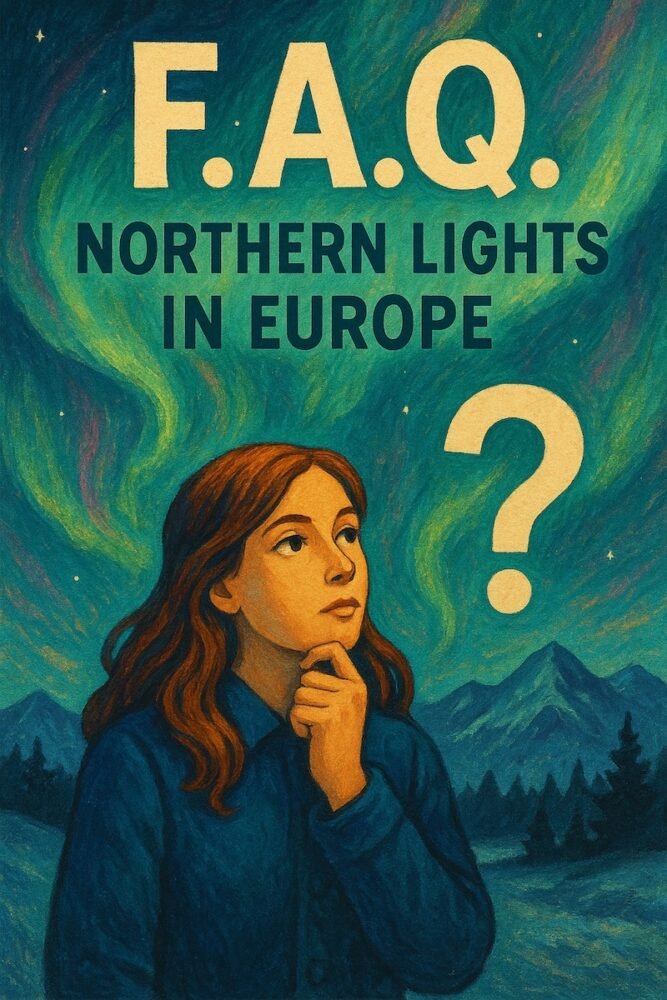
FAQ: 5 Places to Chase the Northern Lights in Europe
When is the best time to see the Northern Lights in Europe?
Your odds are highest from late September to early April when nights are long and dark. Shoulder months (Sep–Oct, Mar–early Apr) offer milder temps; mid-winter (Nov–Feb) brings the longest nights but can be cloudier.
Which European destinations have the most reliable aurora?
These five are stellar picks: Abisko (Sweden), Inari (Finland), Alta (Norway), Akureyri (Iceland), and Shetland (Scotland). Go as far north and as dark as you can for the best chance.
How many nights should I plan in one place?
Aim for 3–5 nights. Weather is fickle; multiple nights dramatically boost your chances while leaving room for daytime fun (saunas, sledding, waterfalls, Viking sites).
Do I need a high KP index to see auroras here?
No. At these latitudes, even KP 1–3 can produce great shows if skies are clear. Cloud cover and darkness beat a big KP number under thick clouds.
What time of night is “prime time”?
There’s no hard rule, but many displays pop between 21:00 and 01:00. Set a couple of alarms and check the sky often—bursts can flare and fade in minutes.
Is a full moon bad for aurora viewing?
Not necessarily. A bright moon lights the landscape (great for photos). You may lose faint arcs, but strong curtains still shine. Adjust camera exposure accordingly.
Can I see the aurora from towns like Akureyri or Alta?
Sometimes, yes—during stronger activity. For consistent results, walk or drive 10–30 minutes to darker viewpoints with a clear northern horizon.
Should I book a guided tour or self-drive?
Both work. A guided chase early in your trip teaches micro-climates and safe pull-outs; then you can DIY the next nights. If you’re uneasy with winter roads, tours are low-stress.
What’s the most budget-friendly option of the five?
Shetland can be gentler on the wallet (UK travel, self-catering). Abisko has solid lodge/hostel options and a famously favorable micro-climate. Akureyri can be good value outside peak holidays.
Do I need a glass igloo to see the lights?
Fun but optional. If budget is tight, pick a dark-sky cabin or guesthouse and invest savings in warm layers or one guided chase night.
What should I pack for long, cold nights out?
Think base–mid–shell layers, insulated boots, warm hat, liner + insulated gloves, hand warmers, thermos, headlamp (red mode), power bank, and microspikes if you’ll be on ice.
Any quick photo settings for beginners?
Start with a fast wide lens at f/1.8–2.8, ISO 1600, 2–6 s shutter (shorter for fast curtains). Manual focus to infinity (tape it). On phones, use Night mode on a tripod for 3–10 s.
Where do you like to chase the Northern Lights?

This scenery of the Northern lights is indeed jaw dropping. quite amazing even in photo, thanks for sharing.
I think I’ll choose Finland for Northern lights. There’s something so charming about Finland that I feel intrigued to visit it.
There is nothing more beautiful than to observe the Northern lights 😍
And I so wish to go Iceland someday.. have you been there?
I’ve always wanted to go to Iceland and you just gave me another reason to add on to my list of reasons to go!
I have it in my bucket list to visit Iceland and enjoy the beautiful Northern lights.